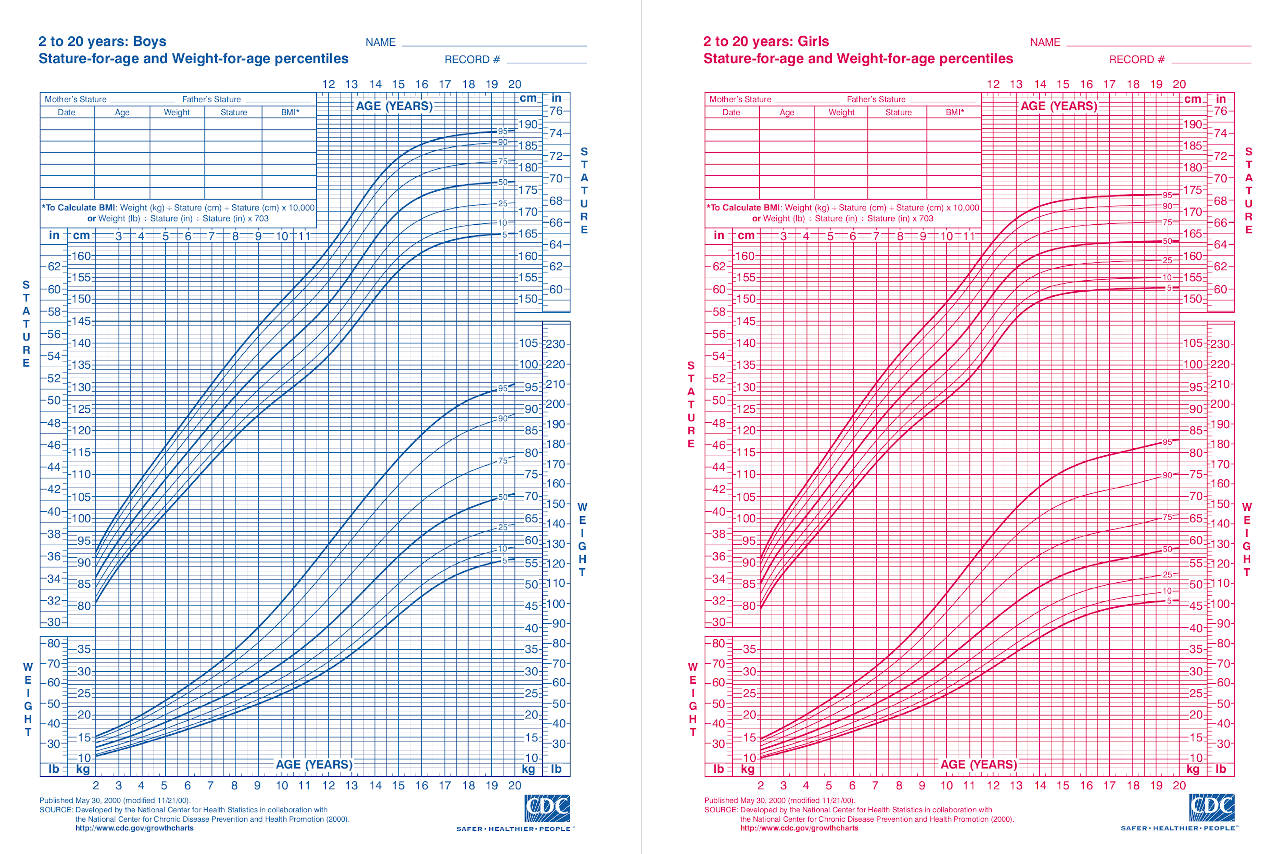Child Height Percentile Calculator
Calculate your child’s height percentile for their age group based on the CDC growth chart data.
Child's Height Percentile:
On this page:
How to Find Child Height Percentile
One way to monitor your children’s development is to calculate what percentile their height falls into based on their age. Girls and boys grow at different rates as they move through childhood and adolescence.
Height standards change with age and sex due to different body structures and hormone fluctuations.
Children don’t grow at a constant rate and typically will have periods where they maintain their height, and then also a time where they hit a “growth spurt” around puberty.
Therefore, growth charts for children have been developed to determine how a child’s height compares to other children of the same age and sex.
These charts are based on data collected from thousands of children worldwide to come up with a standardized height percentile chart. The CDC has developed stature (or height) for age charts for boys and girls.[2]

By simply finding your child’s age on the x-axis and then matching it up with the height (in either inches or centimeters) on the y-axis, you can see what percentile this corresponds to. You can also use a child height percentile calculator like the one mentioned above and type in these values to calculate the percentile.
For example, if you have a 10-year-old boy who is 5 feet tall (or 60 inches), he would fall in the 66th percentile. This means that he is taller than 66% of 10-year-old boys and shorter than 34% of 10-year-old boys.
You can also use a height calculator to estimate how tall your child will be.
How To Interpret Height Percentiles For Boys and Girls
Generally, a child should follow along their percentile line as they get older. If the results go up or down more than two percentile lines, this could be a sign of an underlying health issue and should be discussed with their pediatrician.
In addition, if your child’s height is below the 3rd percentile or above the 97th percentile, their weight should be monitored and followed up with your physician to ensure your child is developing healthily.
Heights below the 3rd percentile or above the 97th percentile are considered short or tall, respectively.[5]
Children With Short Stature Based on Height Percentile
For a child with shorter parents, it may be completely normal for them also to have a short stature for their age. This is known as familial short stature when one or both parents are short, but the child’s growth rate is normal.
Some children may be short during childhood; however, they end up in a normal height range after a late onset of puberty. This is known as a constitutional delay in growth and puberty.
Other times, a child may simply have a short stature with no underlying health issues or identifiable cause. This is known as idiopathic short stature.
After the first year or two of age, familial short stature and constitutional growth delay are the most common causes of short stature. These are both normal, healthy growth patterns.[6]
There are certain health conditions that can also lead to short stature. Hormone deficiencies, such as low growth hormone or thyroid hormone, can lead to delayed or stunted growth. Certain genetic diseases are also associated with shorter children, such as Down’s syndrome.
Consumption of plant proteins, such as rice, has also been found to be associated with some of the shortest statures in the world.[6]
Poor nutrition or diseases that cause malabsorption of nutrients lead to short stature since essential nutrients are required for healthy growth.
Children with Tall Stature Based on Height Percentile
Similar to children with short stature, children may be taller than average and completely healthy. This is common for children with parents who are also tall.
Familial tall stature, also known as constitutional tall stature, is the most common cause of tall stature in children. Their height is consistently above the 97th percentile, and the parental height is above the 90th or 97th percentile.[7]
However, certain health conditions can also cause children to be above the 97th percentile for height. Overnutrition and obesity can cause overgrowth. The consumption of dairy proteins has been correlated with tall stature.[6][8] Specifically, the milk and dairy proteins that were tested were unsweetened, which allowed children to reach their growth potential.[8]
You can also calculate your child’s BMI and then plot it on a BMI chart to exclude obesity as a cause of tall stature.[9] Other health issues include growth hormone excess or certain genetic disorders.
Therefore, your child’s height percentile should be followed closely by their pediatrician.
Monitoring Healthy Development with Children’s Height Percentiles
Boys and girls develop at different rates throughout childhood. This is strongly influenced by genetics, nutrition, and hormone fluctuations. Using height, weight, and BMI percentile graphs and calculators allows you to monitor their growth to ensure this remains at a healthy rate.
Similar Health Calculators
References
- Centers for Disease Control and Prevention, Data Table of Stature-for-age Charts, https://www.cdc.gov/growthcharts/html_charts/statage.htm
- Centers for Disease Control and Prevention, Clinical Growth Charts, 16 June 2017, https://www.cdc.gov/growthcharts/clinical_charts.htm
- Centers for Disease Control and Prevention, 2 to 20 years: Boys, Stature-for-age and Weight-for-age percentiles, https://www.cdc.gov/growthcharts/data/set1clinical/cj41c021.pdf
- Centers for Disease Control and Prevention, 2 to 20 years: Girls, Stature-for-age and Weight-for-age percentiles, https://www.cdc.gov/growthcharts/data/set1clinical/cj41c022.pdf
- Nwosu, B. U., & Lee, M. M., Evaluation of short and tall stature in children, American Family Physician, 2008, 78(5), 597-604. https://www.aafp.org/pubs/afp/issues/2008/0901/p597.html
- Richmond MD, Rogol MD., Causes of Short Stature, UpToDate, https://www.uptodate.com/contents/causes-of-short-stature
- Kumar S., Tall stature in children: differential diagnosis and management, International Journal of Pediatric Endocrinology, 2013, 2013(Suppl 1), P53. https://doi.org/10.1186/1687-9856-2013-S1-P53
- Dor C., Stark A.H., Dichtiar R., Keinan-Boker L., Shimony T., Sinai T., Milk and dairy consumption is positively associated with height in adolescents: results from the Israeli National Youth Health and Nutrition Survey, European Journal of Nutrition , 2022 Feb, 61(1), 429-438. https://pubmed.ncbi.nlm.nih.gov/34406484/
- Davies, J. H., & Cheetham, T., Investigation and management of tall stature, Archives of Disease in Childhood, 2014, 99(8), 72-777. https://adc.bmj.com/content/99/8/772


